The 2013 breeding season began February 3rd with fifteen vultures, including two turkey vultures, being observed outside the Vulture Shed. Three black vultures visited the inside of the shed together on February 5th. Courting and mating by a pair of black vultures were observed on February 11th. Visits to the inside of the shed by a black vulture pair continued through March 2, when mating was observed again. The first egg was laid on March 3 around 7:00 PM and the second laid on March 6 at 8:34 AM. Hatching began April 11, about 39 days later. This is the same elapsed time as for the past two years. Only one of the chicks survived the strenuous 30-hour hatching process. On May 12th, two orphan black vulture chicks were introduced to the nest. The adult birds cared for all three chicks, and they successfully fledged in late June. The birds continued to be seen in and around the shed into August. Numbered wing-tags were placed on the adult male and all three chicks to enable tracking them in future years.
The parents decided to name their unadopted chick “Stephen Colbert,” after the late night TV personality. The parents said they thought Mr. Colbert was cute and they thought about him often, especially when they were hungry. Stephen Colbert’s name has also been given to a falcon, turtle, spider, elephant seal, and ice cream.
Two eggs were laid this year but, sadly, one chick did not survive the strenuous, 30+ hour hatching process. Stephen did fine.
On May 7th, two black vulture chicks from Princess Anne MD, which were orphaned when the barn where they hatched was torn down, were brought to Tri-State Bird Rescue. On May 12th, 29 days after Stephen hatched, the orphan chicks were successfully renested with the vulture family being monitored by Tri-State. All three chicks were cared for by the adults and snuggled together. “V-cube,” the Vigilant Vulture Viewers recording important data on the birds, named the orphans Ethyl and Thiol after mercaptans, the chemicals emitted from carrion that attract vultures. Ethyl had a temporary yellow band on the right leg and later received a permanent tag on the right wing with number 267. Thiol had a temporary red band on the left leg and later received a permanent tag on the left wing with the number 30. Stevie received a permanent tag on the left wing with the number 26. These permanent wing-tags were affixed on June 13th by experienced bird handlers from Hawk Mountain Sanctuary.
Stevie (tag #26) was most recently seen on 3/3/16 in Middletown, DE.
Click on the pictures below to enlarge them.
- Early care, gently rolling them around.
- Beak nuzzling by adults as chicks hatch.
- Stephen at 10 days, healthy and growing.
- Black vulture family at day 10.
- Lunch of nourishing, regurgitated carrion. Yum. Stephen and the parents do their part to keep the entironment clean and free of disease.
- Stephen on his hocks at Day 23
- Stephen on his feet at Day 23
- Stephen at Day 24 With Watchful Parent In Rear Hallway
- Stephen at Day 24- A Bundle of Fluff
- Wing Exercise at Day 25
- Sephen (in front) with foster-chicks, Day 36
- Gang of Three at Day 39


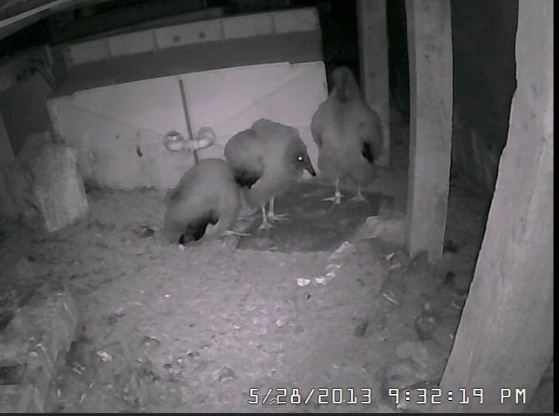
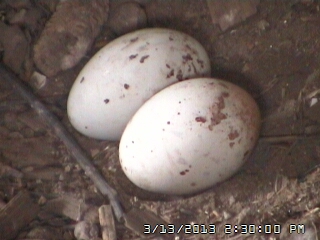



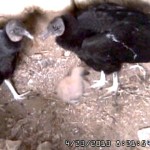

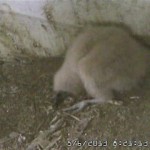
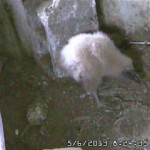
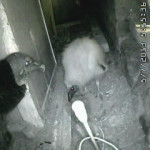



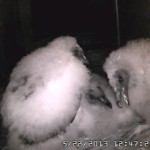
Hi again Karen-
Here is advice from one of Tri-State’s experienced Vets.
“If there is open access to where the chick is now (open barn/garage doors?) so that the adults can get to it, they should leave it where it is. It will also need to have that opening so that it can eventually fledge!
“If the only connection to outdoors is via the second floor, it’s less likely the adults will come down readily to feed it (they might, but it depends on the size and location of the hole).
“If she wanted to leave some roadkill for it, the smell would attract the adults.”
Hi Karen- Just saw your post. Have sent query to Tri-State Bird Rescue for advice. In the meantime, watch to see if parents are tending to it in its new location and if it can get around OK (i.e., is not injured).
We have had two sets of vultures nest in our garage/barn.
They are adorable!!!
This year the only (I think) chick fell through the 2nd floor of the
barn/garage and I don’t know if I should leave him or try to put
him/her back (which would not be a small task) LOL!
I gave it a container of water and a quilt.
Should I try to give it food and what would I give it???
He/she looks like it is about 40 days old according to the pictures
I have seen on the computer.
Can you give me some advice???
I am so upset and do not want this little one to die.
Please help!!!
Karen Matera
New Jersey
We have a nest with 2 eggs in an abandoned truck on our property in central Mississippi that I first saw on May 17. I’m concerned the eggs aren’t going to hatch…went and looked yesterday (6/18) and the eggs are still there. Mama is still on the nest. If the eggs aren’t going to hatch, will the parents give up and abandon the nest?
We continue to watch for any signs of favoritism by the parents for any of the chicks and for signs of preference by any chick for the company of the other chicks. Everyone’s observations would be welcome.
I live in an area that has a vulture roost with most being bl. v’s.
The area they are most seen at is a very large agricultural area
with many old buildings having broken windows and roof holes. I noticed they like those the best. I see them as they are fledged out of nest, so this is a special treat.
The chimney swifts are interesting as well as we seem to have some nesting at this same area where there are brick chimneys.
Thanks
I’d say nuzzling is a rubbing of beaks, separate from a food drop. Another thing to watch for is whether the chick is walking on its hocks or has developed to the point that it can walk on its feet.
QUESTION:
what is considered nuzzling? A greeting or a food drop?
hmm. more to read.
Here is the list of things to watch for that we made at the beginning of the 2013 season (and expanded during the nesting period) to increase our understanding of black vulture nesting:
Adults:
• Ways to differentiate between the individual adults
• Frequency of their “changing the guard”
• Frequency of beak nuzzles upon changing the guard
• Feeding by one adult to another
• Feeding of chicks by regurgitation or by bringing carcasses to the nest
Courting & Mating:
• Mating at the nest site
• Mating relative to time of egg laying
Nest:
• Monitoring the site prior to egg laying
• Preparation of the site
• Objects at the site (bright objects, feathers, etc.)
Eggs & Incubation:
• Elapsed time between laying eggs
• How the pair shares incubation (percentage of time)
• Time adults are on the eggs vs time off.
• Frequency of moving/rolling over eggs
Chicks:
• Elapsed time between hatching of eggs
• Ways to differentiate between individual chicks
• Frequency of being fed
• Competition for food, if any
• Favoritism by adults, if any
• Preference for associating with other chicks, if present
• Timing of plumage changes.
• Extent of Mobility
• Ability to stand on feet as opposed to hocks
• Any other developmental observations
• Reaction to intruders, if any
• First flight
In addition, after birds are tagged, time and location of sightings would be helpful.
Well, if you are looking for any specifics let us know. We will keep watch and take note.
After the egg rolls stop, will we count feedings? probably.
This is exciting.
I casually watched for but did not see serious sibling rivalry last year. It will be good to have more eyes on the chicks this year.
So, who is whom? Pink top, farthest right is egg#1. Top, left is egg #2. Wonder how long this has been here? I’m glued to the cam. Tunnel vision.
Also, the image that is showing now, Early care, this is the Male. I remember this very very well, this was the first time he saw egg # 2. Although his beak is pointed at egg #1, he was admiring them both. Thanks and yes we will try to ID the chicks.
Wonder if the two will duke it out like the TV chicks, aka lil bit and big bit. SO much fun ahead.